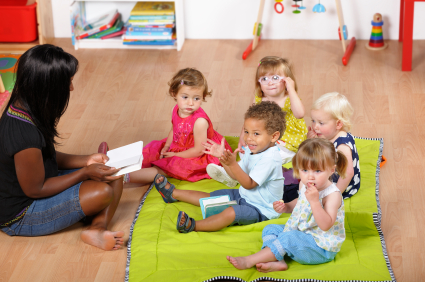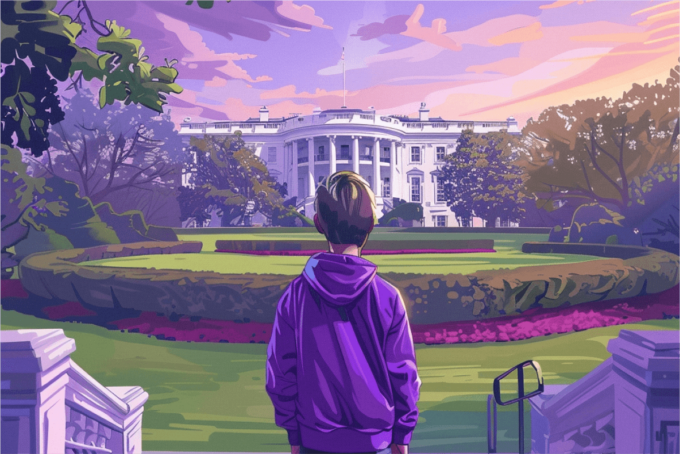“Storytelling is the oldest form of education. Cultures throughout the world have always told tales as a way of passing down their beliefs, traditions, and history to future generations. Why? One reason is that stories are at the core of all that makes us human. Stories are the way we store information in the brain.”
So say professional storytellers Mitch Weiss and Martha Hamilton, who have been preaching the storytelling gospel for over thirty years. And they are hardly alone in their advocacy for storytelling in the classroom. The duo, who perform, teach and write as Beauty and the Beast Storytellers, lead weeklong artists-in-residence workshops in elementary schools along the East coast. Hamilton and Weiss insist that teaching the history and craft of oral tradition to today’s kids is more important than ever.
Perhaps surprisingly, they assert that in this electronic age, persuading educators of the value of such an ancient skill has become easier rather than harder. “Since the mid-1990’s, most states have undertaken a serious educational reform effort. They have adopted educational standards that call for placing greater weight on oral communication, specifically speaking and listening skills, as part of the language arts curriculum. Amazingly enough, these standards relieved us of the burden of always having to explain the relevance of storytelling to most administrators,” explains Hamilton.

I recently interviewed Hamilton and Weiss to get to the bottom of why storytelling matters, and just what goes into (and comes out of) a one-week elementary school storytelling workshop. (Full disclosure: my three children are all graduates of Mitch and Martha workshops held at our elementary school and subsidized by my PTA dues.)
Alison: Please walk me through a ‘typical’ one-week in-school residency. How do schools, teachers, and students prepare in advance of your arrival?
Although we may only work at a school for a week, the residency begins long before our arrival. At least a month before our visit we send a large packet of preparation materials for the classroom teachers involved; 55-60 stories, almost exclusively world folktales that we have rewritten for the students to tell.
We ask that the teachers prepare their classes in several ways. First, they must help the students choose stories. This is an extremely important component for making the project successful. Each child needs to LOVE the story that he or she has chosen. We want to stretch them a bit, but if the language is too difficult they won’t be successful. In order to avoid problems with copyright, we research and retell as many folktales as possible each year. Many of them have been published in our books in the past, but we always write new ones each year in order to keep things fresh for us and everyone at the schools where we work every year.
Some teachers read all the stories out loud to their students – the stories were meant to be heard orally, after all. This is especially good for students who may struggle with reading. Teachers are often stunned to find that some of the children with learning problems are the best storytellers. Classroom teachers frequently lean on special area teachers (special ed, reading, English Language Learners) throughout the process. These teachers can help the students they work with to choose appropriate stories and coach them before we arrive. These special area teachers are frequent collaborators in our project. A letter goes home to parents asking them to be willing listeners and to encourage their children to practice daily.
Alison: So the students have chosen their stories…what next?
We ask that teachers direct their students in drawing story maps. Detailed instructions are included in our packet of materials that the teachers receive. We feel that this is a vital step in learning a story. A story map is to help tellers “see” their stories as a series of pictures. It is a depiction of the “skeleton” or “bones” of the story. As students tell the story, they add ”flesh” by telling it in their own words. We emphasize that we are teaching them how to tell a story – and that when we tell others about things that happened to us, we do not memorize a script.
Students then begin to learn and practice their stories with a slowly expanding audience – first they practice telling to the wall, and then to one partner, then two, small groups, and so on. They are also encouraged to practice in many ways at home – in the mirror, for family members, and eventually perhaps recording themselves and watching their own telling.
Alison: Once you arrive at school for the week, how do you work with the staff and students to develop their confidence and communicate the purpose of the project?
When we arrive, we begin with performances for the general school population. We then give an introductory workshop in each participating classroom. This is an extremely interactive workshop with a lot of modeling of storytelling skills, including voice and facial and body expression. Then, over the course of a week, we individually coach the students on their stories. We encourage the classroom teacher to participate in the coaching sessions with us. Their help is invaluable since they know the kids so much better than we do. Special area teachers, aides, or parents can be invaluable during this part of the process.
We usually end with a family event, when the students get a chance to share their stories with their families. We encourage teachers to send their students to other classrooms. It makes a huge difference in their confidence levels if they go to other classrooms to tell their stories before the culminating family storytelling festival. By doing this they learn the powerful lesson that public speaking is like anything else – you grow more comfortable and get better every time you do it.
The more we have been at a school over the years, the better the child tellers are. Teachers have done the project and know how to best prepare and help their students. Furthermore, those students may have fears about doing it, but they have seen that it is well within the grasp of children to stand up in front of a class and entertain audience members with a story. We emphasize to the adult listeners at the culminating event that they should think of what they are about to see not as a “show,” although they will certainly be entertained, but rather the children learning to find their own language and use gestures, facial and vocal expression, and eye contact to make a story come alive.
Alison: Please comment on the relevancy, frustrations, and gratifications of celebrating old-school communication skills with 21st century children. I’m particularly curious to hear how your mastery of and joy in storytelling connects with students accustomed to texting, iChatting, IMing, etc. I’ve seen for myself the frenzy your visits whip up in the eight-year-old set, and my hypothesis is that they receive your talents and message with a sense of novelty and excitement partly because they are exposed to less face-to-face sharing than their parents were at the same age.
We think the main reason that storytelling can be so engaging and captivating is that human connection is crucial for all of us. Computers and machines are, in the end, just computers and machines. People can forge strong bonds by texting but they will still long to be touched or to look right into another person’s eyes.
On our website we publish thank you notes and endorsements from students, parents and educators. One anonymous parent spoke to this idea:
With so much focus on Facebook and texting among young people today, they learn to be confident in a virtual world, and yet many do not have the social skills needed to communicate face-to-face with others. As I watched my daughter and the other third graders confidently stand and tell their stories in front of the large group of their classmates and families, I was impressed by their vocal and facial expression, use of gestures, and eye contact. More emphasis needs to be placed on the kinds of skills that the storytelling project teaches.
Alison: Earlier, you said you include special educations teachers, aides, and reading specialists in your school workshops. You also mentioned that often children with learning difficulties perform particularly well in these oral projects. Are you fans of Howard Gardner’s work on multiple intelligences? If so, how is that relevant to your work?
We’ll cite the first chapter of our book Children Tell Stories:
“Every time we teach storytelling to a classroom of students, the teacher inevitably points out that some of the children who struggle with reading and writing are among the best storytellers in the class. In our early years of teaching storytelling we were lucky enough to work with the same children three years in a row as third, fourth, and fifth graders. At one of the schools, a boy named Anthony stood out each year because he was so funny and creative. We had never happened to talk with his third or fourth grade teachers specifically about him. But when we met his fifth grade teacher in the teachers’ room one day, we said, “Wow! Isn’t Anthony extraordinary? Every year he amazes us by the way he tells his story.” She replied, “He’s incredible! But do you realize that he’s severely learning disabled? Although he’s quite smart, he’s far behind all the other kids in reading and writing.” We would never have guessed. While listening to him and his classmates tell stories it was impossible to tell the difference between him and other bright kids in the class. This incident made us more acutely aware of the fact that we all learn in different ways. Gardner’s theory of multiple intelligences emphasizes the idea that children learn at their own rate and in their own style. It was through storytelling that Anthony was able to demonstrate his language skills. Teachers need to provide many different kinds of literacy experiences to meet individual needs.”
**********
Mitch and Martha are eloquent and experienced advocates for their craft. Objective thinkers considering the value of storytelling as part of the classroom would do well to consider some of the pair’s most relevant and compelling talking points:
- Storytelling offers an opportunity for a level playing field, allowing learning disabled and otherwise challenged students to excel in oral (rather than written) communication.
- The story mapping involved in the exercise helps students to distill a narrative to its most fundamental parts. This is a skill that translates to their reading comprehension and their processing of written materials.
- Public speaking – often cited as the No. 1 fear of adults, including death – is a skill like any other: you grow better and more comfortable every time. Exposure at a young age will help to dampen this fear.
- 21st century children are e-drowning in “No Eye Contact Necessary” social interaction. Telling a story to a room of friends and family is no longer part of a typical day, but rather an occasion to be savored and celebrated.
- Finally, storytelling helps to nurture the imagination. As Mitch and Martha write in Children Tell Stories, “Stories tap deep into the unconscious of listeners, engage their emotions, and hold them in a powerful grip. A good story has the ability to make the here and now disappear for listeners. Though the teller tells one story, many stories are created by the listeners, tales filled with their own images, feelings, colors, sounds, and other details.”
Talking to parents, educators, and students, a consensus emerges that the real value of a storytelling workshop is in the intangibles. Parents, for instance, most frequently cite the self-confidence that comes with commanding the attention of a room with a story, a moral, or a joke. Teachers say the story mapping work helps students to develop a way of organizing information and ideas. And kids report that speaking without a script may have once sounded as scary as jumping without a net, but in the end proved to be just as exhilarating.
It’s an amusing truism that when asked to name their biggest fears, adults overwhelmingly put public speaking at the top of the list. Mitch and Martha are working toward reversing that trend, helping to bring up a generation of kids who enjoy being in front of the room.



